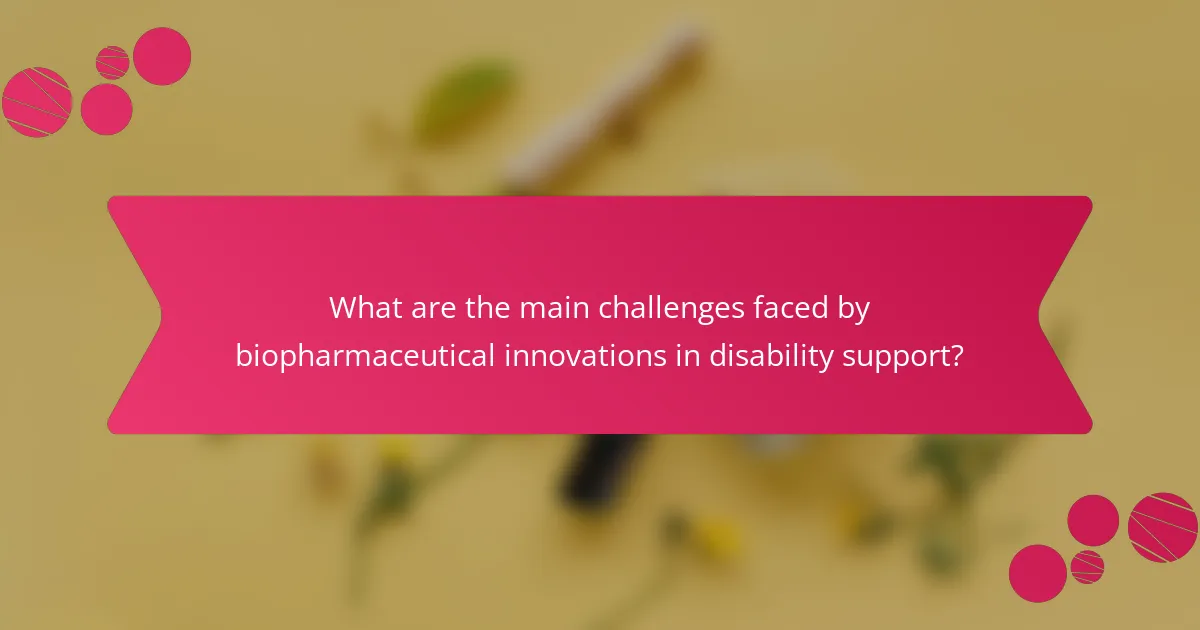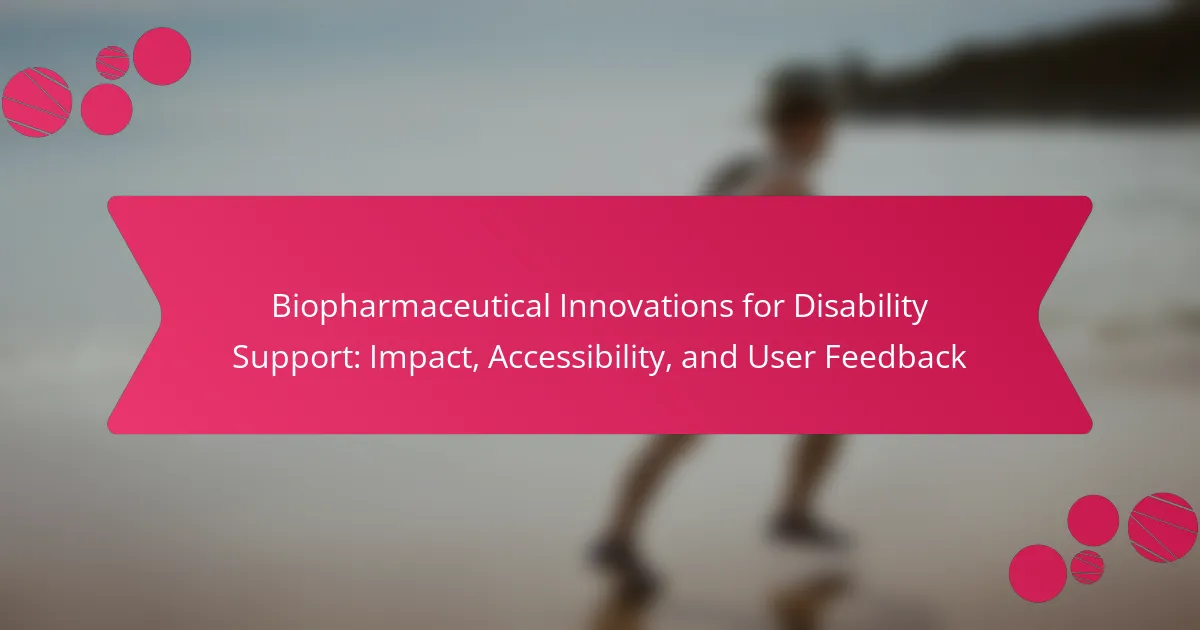Biopharmaceutical innovations significantly improve disability support by enhancing treatment efficacy and accessibility. These advancements lead to personalised therapies that address specific disabilities, fostering independence. User feedback plays a crucial role in shaping these innovations, guiding improvements in drug delivery systems and overall patient satisfaction. Despite challenges such as affordability and regulatory hurdles, these developments are transforming the quality of life for individuals with disabilities.

How do biopharmaceutical innovations enhance disability support?
Biopharmaceutical innovations significantly enhance disability support by improving treatment efficacy and accessibility. These advancements provide tailored therapies that address specific disabilities, leading to better health outcomes. User feedback indicates increased satisfaction with personalised treatment options. Moreover, innovations in drug delivery systems enhance access, ensuring patients receive necessary medications efficiently.
What are the key features of biopharmaceutical solutions for disabilities?
Biopharmaceutical solutions for disabilities feature advanced therapies, personalised treatment plans, and improved accessibility. These innovations enhance patient outcomes, offering tailored approaches based on individual needs. User feedback highlights the effectiveness of these solutions in managing symptoms and improving quality of life. Accessibility remains a core focus, ensuring that therapies are available to diverse populations.
Which conditions benefit most from biopharmaceutical advancements?
Biopharmaceutical advancements significantly benefit conditions such as cancer, autoimmune disorders, and neurological diseases. These innovations enhance treatment efficacy and accessibility for individuals with disabilities. For example, targeted therapies improve outcomes for cancer patients, while biologics offer new hope for those with autoimmune conditions. User feedback highlights increased quality of life and functional improvements, reinforcing the positive impact of these advancements.

What impact do these innovations have on user quality of life?
Biopharmaceutical innovations significantly enhance user quality of life by improving accessibility and functionality. These advancements enable individuals with disabilities to engage more fully in daily activities, thereby fostering independence. For example, personalised medications can lead to better management of health conditions, resulting in increased participation in social and professional environments. User feedback indicates a notable increase in satisfaction and overall well-being due to these innovations.
How do users perceive the effectiveness of biopharmaceutical products?
Users generally perceive biopharmaceutical products as effective for managing disabilities, especially when they experience significant symptom relief. Feedback highlights improved quality of life and functionality. Accessibility remains a concern, with users advocating for broader availability and affordability. Clinical trials and user testimonials often reinforce perceptions of efficacy, demonstrating tangible benefits in daily activities and overall health.
What are the emotional and psychological benefits reported by users?
Users report various emotional and psychological benefits from biopharmaceutical innovations for disability support. These benefits include enhanced well-being, improved self-esteem, and increased social engagement. Many individuals experience reduced anxiety and depression due to effective symptom management. Additionally, users often express a sense of empowerment and control over their health, fostering a positive outlook on life. This feedback highlights the innovations’ significant role in enhancing mental health and quality of life for individuals with disabilities.

How accessible are biopharmaceutical innovations for individuals with disabilities?
Biopharmaceutical innovations are increasingly accessible for individuals with disabilities, yet challenges remain. Advances in personalised medicine enhance treatment effectiveness, while telehealth options improve access. However, affordability and awareness still hinder widespread adoption. User feedback highlights the need for better communication and support services.
What barriers exist in accessing biopharmaceutical treatments?
Barriers to accessing biopharmaceutical treatments include high costs, limited insurance coverage, and complex regulatory pathways. These factors restrict availability, particularly for individuals with disabilities. Additionally, geographic disparities and lack of awareness further hinder access. Addressing these barriers is essential for improving treatment outcomes.
How do regional differences affect accessibility to these innovations?
Regional differences significantly impact accessibility to biopharmaceutical innovations for disability support. Variations in healthcare infrastructure, regulatory environments, and economic conditions create disparities in availability and adoption. For instance, urban areas often have better access to advanced treatments compared to rural regions. Additionally, cultural attitudes towards disability can influence the acceptance and integration of these innovations. As a result, the effectiveness of biopharmaceuticals in supporting individuals with disabilities can vary greatly depending on the region.

What role does user feedback play in shaping biopharmaceutical developments?
User feedback is crucial in shaping biopharmaceutical developments, as it directly influences product design and efficacy. Engaging users allows developers to understand real-world challenges faced by individuals with disabilities. This feedback leads to innovations that enhance accessibility and usability. For instance, user input can guide the formulation of medications that are easier to administer or adjust dosage forms to meet specific needs. Ultimately, incorporating user feedback fosters a more patient-centred approach, improving overall treatment outcomes and satisfaction.
How can user experiences influence future product designs?
User experiences significantly shape future product designs by providing insights into needs and preferences. Feedback from users with disabilities informs the development of biopharmaceutical innovations, ensuring they are accessible and effective.
For example, user input can lead to modifications in dosage forms, making them easier to use for individuals with specific disabilities. Additionally, incorporating user experiences can enhance the overall usability of products, improving adherence and satisfaction.
As a result, biopharmaceutical companies that prioritise user feedback are more likely to create successful and impactful solutions that genuinely support individuals with disabilities. This user-centric approach fosters innovation and aligns product offerings with real-world requirements.
What methods are used to gather user feedback effectively?
Effective methods for gathering user feedback include surveys, focus groups, interviews, and usability testing. Each method provides unique insights into user experiences and preferences. Surveys can reach a broad audience quickly, while focus groups facilitate in-depth discussions. Interviews offer personalised feedback, and usability testing identifies specific areas for improvement. Combining these approaches enhances overall feedback quality and drives biopharmaceutical innovations for disability support.

Which biopharmaceutical companies are leading in disability support innovations?
Leading biopharmaceutical companies in disability support innovations include Biogen, Amgen, and Novartis. These companies focus on developing therapies that enhance accessibility and improve patient outcomes. Biogen is known for its advancements in neurological disorders, while Amgen emphasises biologics for chronic conditions. Novartis has made significant strides in gene therapies aimed at rare disabilities. User feedback highlights the positive impact of these innovations on daily living and overall quality of life.
What unique approaches are being adopted by these companies?
Innovative companies are adopting unique approaches to enhance biopharmaceutical innovations for disability support. These include personalised medicine, which tailors treatments to individual genetic profiles, improving efficacy and minimising side effects. They are also integrating advanced technologies like artificial intelligence to streamline drug discovery and development, leading to faster and more accessible solutions. Furthermore, companies are emphasising user feedback in the design process, ensuring products meet the actual needs of users, thereby enhancing usability and satisfaction. Lastly, partnerships with advocacy groups are being formed to raise awareness and improve accessibility for disabled individuals, creating a more inclusive environment.
How do these companies address diverse user needs?
Biopharmaceutical companies address diverse user needs through tailored innovations, accessibility initiatives, and user feedback integration. They develop specialised treatments that consider varying disabilities and their impact on daily activities. For instance, companies often collaborate with healthcare professionals to ensure that products meet specific user requirements. Additionally, they implement user-friendly designs and support programmes to enhance accessibility. User feedback is actively sought to refine these innovations and ensure they effectively address real-world challenges.

What are the main challenges faced by biopharmaceutical innovations in disability support?
Biopharmaceutical innovations in disability support face several significant challenges. These include high development costs, regulatory hurdles, and issues with accessibility for users.
High costs can limit the availability of new therapies, making them unaffordable for many individuals. Regulatory hurdles often delay the introduction of innovative solutions to the market, impacting timely access for those in need. Accessibility issues arise from a lack of tailored solutions for diverse disabilities, which can hinder effective use and integration into daily life.
User feedback is crucial in addressing these challenges, as it can guide improvements and adaptations in biopharmaceutical offerings. Engaging with users ensures that innovations meet their specific needs and enhance overall support.
How do regulatory hurdles impact the development of new treatments?
Regulatory hurdles significantly delay the development of new treatments. They impose stringent requirements that biopharmaceutical companies must navigate, affecting innovation timelines and accessibility. For instance, lengthy approval processes can extend development periods by years, limiting the availability of potentially life-changing therapies for individuals with disabilities. Additionally, the complexity of regulations may deter investment in high-risk innovations, ultimately impacting the diversity of treatment options available.
What are the common misconceptions about biopharmaceuticals in disability support?
Common misconceptions about biopharmaceuticals in disability support include beliefs that they are only for severe conditions, are too expensive, and lack sufficient research. Many assume these therapies are inaccessible, overlooking growing availability and affordability programmes. Additionally, some think user feedback is predominantly negative, ignoring positive experiences reported by many patients.
What best practices can improve the integration of user feedback into biopharmaceutical innovations?
Integrating user feedback into biopharmaceutical innovations can be improved through structured approaches. Engaging users early in the development process enhances relevance and accessibility. Regularly conducting surveys and focus groups allows for continuous input, ensuring that innovations address real needs. Collaborating with disability advocacy groups provides valuable insights and fosters trust. Implementing iterative design processes incorporates feedback at multiple stages, refining solutions effectively. Finally, utilising digital platforms for feedback collection broadens participation and captures diverse perspectives.
